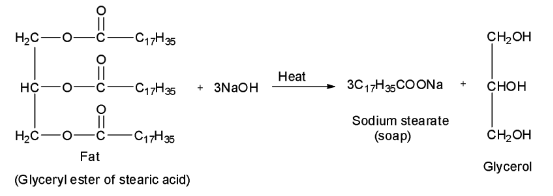
An example of soap is:
A. \[{{\text{C}}_{{\text{17}}}}{{\text{H}}_{{\text{35}}}}{\text{COONa}}\]
B. ${\text{C}}{{\text{H}}_{\text{3}}}{\text{COONa}}$
C. ${\text{C}}{{\text{H}}_{\text{3}}}{\text{ONa}}$
D. \[{{\text{C}}_{{\text{17}}}}{{\text{H}}_{{\text{35}}}}{\text{COO}}{{\text{C}}_2}{{\text{H}}_5}\]
Answer
220.8k+ views
Hint: Soaps are a class of surfactants which are chemical substances that concentrate at the surface of the solution, form surface films, reduce surface tension of the solution and emulsify grease.
Soaps are actually potassium or sodium salts of higher fatty acids such as lauric acid $\left( {{{\text{C}}_{{\text{11}}}}{{\text{H}}_{{\text{23}}}}{\text{COOH}}} \right)$ or palmitic acid $\left( {{{\text{C}}_{{\text{15}}}}{{\text{H}}_{{\text{31}}}}{\text{COOH}}} \right)$ .
Complete step by step answer:
Soaps are surface active agents and they can remove dirt and dust by emulsifying grease. So, they act as cleansing agents. The molecule of soaps consists of two characteristic groups, one of which is water soluble or hydrophilic and the other is oil soluble or lipophilic.
Soaps are formed by heating fat or oil, or in other words, glyceryl esters of fatty acids with aqueous sodium hydroxide solution. Alcohol is also formed in this process. This process of conversion of fats, oils or lipids into soap and alcohol is known as saponification reaction.
Now, out of the given four options, only the first option is a sodium salt of a higher fatty acid, i.e. \[{{\text{C}}_{{\text{17}}}}{{\text{H}}_{{\text{35}}}}{\text{COONa}}\] is a sodium salt of a higher fatty acid called stearic acid having the formula \[{{\text{C}}_{{\text{17}}}}{{\text{H}}_{{\text{35}}}}{\text{COOH}}\] . Therefore, it is a soap called sodium stearate. It is formed by the saponification of glyceryl ester of stearic acid. Thus, option A is correct.

${\text{C}}{{\text{H}}_{\text{3}}}{\text{COONa}}$ is sodium acetate, ${\text{C}}{{\text{H}}_{\text{3}}}{\text{ONa}}$ is sodium methoxide and \[{{\text{C}}_{{\text{17}}}}{{\text{H}}_{{\text{35}}}}{\text{COO}}{{\text{C}}_2}{{\text{H}}_5}\] is an ester of a higher fatty acid. Therefore, they are not soaps and so the options B, C and D are not correct.
Note:
Soap is a good cleansing agent and is completely biodegradable. Thus, it does not create any pollution problems.
But there are two disadvantages. One of them is soaps cannot be used in hard water because calcium and magnesium ions present in hard water produces curdy white precipitates of calcium and magnesium salts of fatty acids. These get precipitated as scum and some parts of soap is wasted.
Another disadvantage is soaps cannot be used in acidic solutions because acids precipitate the insoluble free fatty acids which adhere to the fabric and thereby lowers the ability to remove oil and grease from the fabric.
Soaps are actually potassium or sodium salts of higher fatty acids such as lauric acid $\left( {{{\text{C}}_{{\text{11}}}}{{\text{H}}_{{\text{23}}}}{\text{COOH}}} \right)$ or palmitic acid $\left( {{{\text{C}}_{{\text{15}}}}{{\text{H}}_{{\text{31}}}}{\text{COOH}}} \right)$ .
Complete step by step answer:
Soaps are surface active agents and they can remove dirt and dust by emulsifying grease. So, they act as cleansing agents. The molecule of soaps consists of two characteristic groups, one of which is water soluble or hydrophilic and the other is oil soluble or lipophilic.
Soaps are formed by heating fat or oil, or in other words, glyceryl esters of fatty acids with aqueous sodium hydroxide solution. Alcohol is also formed in this process. This process of conversion of fats, oils or lipids into soap and alcohol is known as saponification reaction.
Now, out of the given four options, only the first option is a sodium salt of a higher fatty acid, i.e. \[{{\text{C}}_{{\text{17}}}}{{\text{H}}_{{\text{35}}}}{\text{COONa}}\] is a sodium salt of a higher fatty acid called stearic acid having the formula \[{{\text{C}}_{{\text{17}}}}{{\text{H}}_{{\text{35}}}}{\text{COOH}}\] . Therefore, it is a soap called sodium stearate. It is formed by the saponification of glyceryl ester of stearic acid. Thus, option A is correct.

${\text{C}}{{\text{H}}_{\text{3}}}{\text{COONa}}$ is sodium acetate, ${\text{C}}{{\text{H}}_{\text{3}}}{\text{ONa}}$ is sodium methoxide and \[{{\text{C}}_{{\text{17}}}}{{\text{H}}_{{\text{35}}}}{\text{COO}}{{\text{C}}_2}{{\text{H}}_5}\] is an ester of a higher fatty acid. Therefore, they are not soaps and so the options B, C and D are not correct.
Note:
Soap is a good cleansing agent and is completely biodegradable. Thus, it does not create any pollution problems.
But there are two disadvantages. One of them is soaps cannot be used in hard water because calcium and magnesium ions present in hard water produces curdy white precipitates of calcium and magnesium salts of fatty acids. These get precipitated as scum and some parts of soap is wasted.
Another disadvantage is soaps cannot be used in acidic solutions because acids precipitate the insoluble free fatty acids which adhere to the fabric and thereby lowers the ability to remove oil and grease from the fabric.
Recently Updated Pages
The hybridization and shape of NH2 ion are a sp2 and class 11 chemistry JEE_Main

What is the pH of 001 M solution of HCl a 1 b 10 c class 11 chemistry JEE_Main

Aromatization of nhexane gives A Benzene B Toluene class 11 chemistry JEE_Main

Show how you will synthesise i 1Phenylethanol from class 11 chemistry JEE_Main

The enolic form of acetone contains a 10sigma bonds class 11 chemistry JEE_Main

Which of the following Compounds does not exhibit tautomerism class 11 chemistry JEE_Main

Trending doubts
JEE Main 2026: Application Form Open, Exam Dates, Syllabus, Eligibility & Question Papers

Derivation of Equation of Trajectory Explained for Students

Hybridisation in Chemistry – Concept, Types & Applications

Understanding the Angle of Deviation in a Prism

How to Convert a Galvanometer into an Ammeter or Voltmeter

Degree of Dissociation: Meaning, Formula, Calculation & Uses

Other Pages
NCERT Solutions For Class 11 Chemistry Chapter 7 Redox Reaction

JEE Advanced Marks vs Ranks 2025: Understanding Category-wise Qualifying Marks and Previous Year Cut-offs

Hydrocarbons Class 11 Chemistry Chapter 9 CBSE Notes - 2025-26

Thermodynamics Class 11 Chemistry Chapter 5 CBSE Notes - 2025-26

NCERT Solutions ForClass 11 Chemistry Chapter Chapter 5 Thermodynamics

Equilibrium Class 11 Chemistry Chapter 6 CBSE Notes - 2025-26




